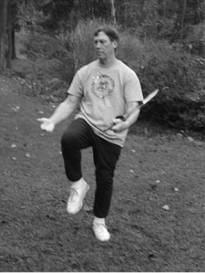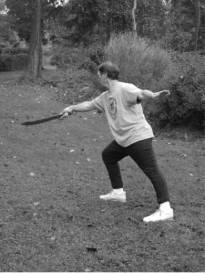 Gilman Studio On-Line Lessons
Gilman Studio On-Line Lessons
Yang Style
Tai Chi Dao/Saber/Broadsword
This Lesson Contains:
Movement # 26 – Strike Opponent’s Ears With Both Fists
Movement # 27 – Change Saber Hand And Chop Downward
I have reached a moment where I have had to make a difficult decision. When I learned Strike Opponent’s Ears, it never seemed to make sense from a martial aspect. It was also difficult to keep the form alive when making the transition between this movement and the one that follows. For 30 years I practiced and taught it in the form as I learned it. When I started this web course, I knew I was going to be faced with what to do with a movement that I really didn’t think fit. Yet I didn’t want to completely eliminate it from the form, so I made a compromise. I have combined it with the movement that follows in order to improve flow and clarity. I apologize to my Tai Chi ancestors for being so bold.
As it now stands, following the Right Foot Kick With Sole, the opponent falls back to avoid the kick. I quickly change saber hands and chop downward to her shoulder.
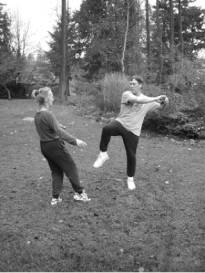
 1) Following the foot kick, I change saber hands.
1) Following the foot kick, I change saber hands.
2) I chop downward to Stephie’s shoulder.
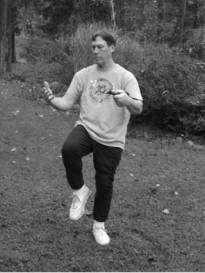
 Movement # 26 – Strike Opponent’s Ears
Movement # 26 – Strike Opponent’s Ears
Following the kick, the energy relaxes into the center.
Pull the right foot back until the lower leg hangs down and relaxes. The weight sinks deeper into the left leg. The body still faces halfway between north and east.
The two arms rotate until the palms face inward and they start to drop down the front of the body.
Focus on the energy returning to the center.
The two arms continue to drop or press downward along the front of the body.
Continue to focus on the center.
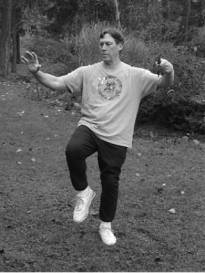 The end of Strike Opponent’s Ears.
The end of Strike Opponent’s Ears.
Up until very recently, at this point I would have formed a fist with the right hand and pressed the two hands together, like in the Long Form movement of the same name. Purists could still do that and I would support their effort.
Keep the right leg up.
The two arms have actually made large circles or arcs on either side of the body to arrive at this point. After having dropped down the front of the body to the waist, they expand up and out with the hands rotating until the palms again face outward. Those of you who practice the Yang Long Form will be familiar with this movement.
Continue to focus on the center.

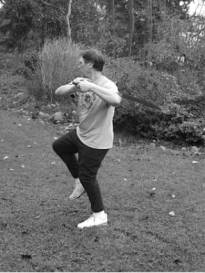 Movement # 27 – Change Saber Hand and Chop Downward.
Movement # 27 – Change Saber Hand and Chop Downward.
Keep the right leg up. Turn the torso to the left until the nose points to the left knee. Be careful not to twist the left knee and keep the weight sinking down on this leg.
Reach over to the left with the right hand and take a hold of the saber handle.
Focus on the change of hands.

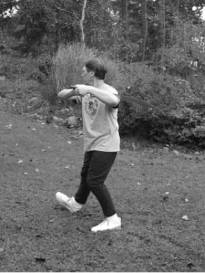 Step down with the right heel. Don’t add weight yet. The toe faces halfway between north and east. Be careful not to fall onto the right foot when placing it down. This step requires a sinking deeper into the left supporting leg.
Step down with the right heel. Don’t add weight yet. The toe faces halfway between north and east. Be careful not to fall onto the right foot when placing it down. This step requires a sinking deeper into the left supporting leg.
The right hand starts to separate from the left. The saber blade rests on the left forearm near the elbow.
Focus on the step and the target.
Shift the weight onto the right foot and lean slightly forward extending the body to about a 45-degree angle. Be sure to keep the weight and balance behind the right foot. It is easy to move the weight too far forward on the right foot so the heel lifts and the root is severed. The torso is still turned slightly to the left.
The right arm chops downward and ends in line with the right leg. The blade is at about a 45-degree angle down. The left hand has opened back and ends in line with the left leg with the palm facing outward. The two arms moving outward with the same speed and energy, like pulling a rubber band apart, is important for balance.
Focus on the cutting edge of the blade.

